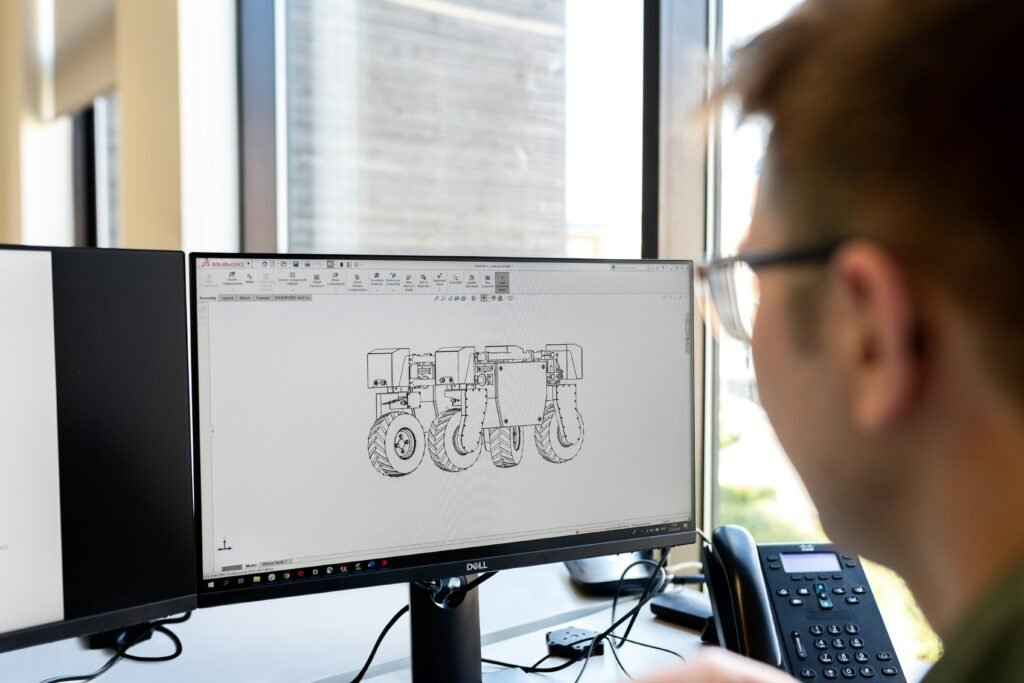Imagine a world where production is faster, more efficient, and less strenuous for workers. A world where state-of-the-art equipment and cutting-edge machines seamlessly take over mundane and repetitive tasks, allowing humans to focus on more creative and complex work. This is not a distant dream, but a reality that is already transforming industries across the globe. From advanced robotics to automated assembly lines, businesses are revolutionizing production processes, harnessing the power of technology to streamline operations and maximize productivity. In this article, we will explore the incredible advancements in manufacturing and delve into how these cutting-edge machines are reshaping the future of production. Prepare to be amazed by the possibilities that lie ahead!

This image is property of images.unsplash.com.
Improved Efficiency
Efficiency is a key factor in any manufacturing process, and with the advancements in technology, improved efficiency has become a reality. Modern machines and equipment have allowed for decreased production time, meaning that products can be manufactured at a faster rate than ever before. This not only reduces costs but also allows companies to meet the demands of their customers more effectively.
Not only does the use of cutting-edge machines decrease production time, but it also increases output. These machines are capable of performing tasks at a much higher capacity, resulting in a higher quantity of products being produced. This is especially beneficial for industries where there is high demand, as it allows companies to keep up with the market and stay ahead of their competitors.
One of the most significant advantages of using advanced machines in manufacturing is the reduced human error. While human intervention is still crucial, automated processes help minimize the potential for mistakes. By utilizing machines for repetitive or precise tasks, companies can ensure that every product meets the required standards. This not only improves the quality of the final product but also saves both time and resources that would have otherwise been spent on rejections or rework.
Automated Processes
Automated processes have revolutionized manufacturing operations by streamlining various tasks. With the integration of cutting-edge machines, operations can be carried out in a much more efficient and precise manner, resulting in reduced wastage and improved overall quality control.
One of the greatest advantages of using advanced machines is the faster manufacturing cycles. With the use of robotics and automation, tasks that once took hours or even days can now be completed in a matter of minutes. This not only increases productivity but also allows for better planning and scheduling of production, leading to improved customer satisfaction.
Furthermore, automated processes ensure consistent quality control. Machines are programmed to perform tasks with a high level of accuracy and precision, which in turn guarantees the quality of the final product. By minimizing human error, companies can ensure that their products consistently meet or exceed customer expectations.

This image is property of images.unsplash.com.
Enhanced Precision
Precision is essential in manufacturing, especially for industries that deal with complex designs or products with tight tolerances. State-of-the-art machines offer precision within microns, allowing for the creation of intricate and delicate components. This level of precision ensures that products are manufactured to exact specifications, resulting in improved product performance and customer satisfaction.
Accurate measurements are crucial for ensuring the quality of a product. Advanced measuring tools integrated into modern machines enable precise and reliable measurements. This not only helps in maintaining consistency in product dimensions but also aids in detecting any deviations or defects early on, allowing for quick corrective actions to be taken.
With the use of cutting-edge machines, complex designs that were once deemed impossible are now achievable. Whether it’s intricate patterns or intricate shapes, these machines can handle the complexity and deliver products with the highest level of precision. This opens up new possibilities for manufacturers, allowing them to explore innovative designs and cater to a wider range of customer demands.
Advanced Robotics
The integration of advanced robotics in manufacturing processes has brought about numerous benefits, leading to improved efficiency, productivity, and safety measures.
One notable advantage of advanced robotics is increased flexibility. These robots are capable of performing a wide range of tasks and can easily be programmed to switch between different operations or products. This flexibility allows companies to adapt quickly to changing market demands, improve production line efficiency, and even enable mass customization.
Higher productivity is another significant benefit of advanced robotics. These machines are designed to work at a much faster pace than humans and can perform tasks with a high level of precision and accuracy. By automating repetitive or physically demanding tasks, companies can significantly increase their overall productivity and output.
Safety is always a concern in manufacturing, but the use of advanced robotics has led to improved safety measures. By replacing workers in potentially hazardous environments with robots, the risk of injuries or accidents can be dramatically reduced. Additionally, robots are equipped with sensors and safety features that ensure safe collaboration with human workers, further enhancing workplace safety.

This image is property of images.unsplash.com.
Artificial Intelligence Integration
Artificial intelligence (AI) integration has transformed manufacturing by enabling predictive maintenance, optimized resource allocation, and smart decision-making.
Predictive maintenance is a game-changer in manufacturing. By using AI algorithms and data analysis, machines can detect potential issues or failures before they occur. This allows for timely maintenance or repairs, minimizing downtime and improving overall equipment efficiency. Predictive maintenance not only saves costs but also prolongs the lifespan of machines, ensuring smooth operations.
Optimized resource allocation is crucial for maximizing efficiency in manufacturing. AI-powered systems can analyze data and make recommendations on how resources, such as raw materials or energy, can be utilized most effectively. By optimizing resource allocation, companies can minimize waste and reduce costs, ultimately improving their overall profitability.
Smart decision-making is an invaluable benefit of AI integration. By collecting and analyzing vast amounts of data, AI systems can provide valuable insights and recommendations. This helps manufacturers make informed decisions about production planning, inventory management, and other critical aspects. With AI-powered systems providing real-time intelligence, companies can stay ahead of market trends, make strategic decisions, and maintain a competitive edge.
Internet of Things (IoT) Connectivity
The Internet of Things (IoT) has revolutionized manufacturing by enabling real-time monitoring and control, remote access and management, and data-driven insights.
Real-time monitoring and control are essential for ensuring optimal performance and efficiency in manufacturing processes. By connecting machines, sensors, and other devices to the IoT network, manufacturers can monitor various parameters, such as temperature, pressure, or performance, in real-time. This allows for immediate detection of issues or deviations and enables proactive measures to be taken to prevent disruptions or quality issues.
Remote access and management have become increasingly important in today’s globalized manufacturing industry. IoT connectivity allows manufacturers to remotely access and monitor their equipment and processes from anywhere in the world. This enables companies to oversee operations, troubleshoot problems, and even make adjustments or optimizations without physical presence. Such remote access and management capabilities save time and resources, especially for companies with multiple manufacturing sites or global operations.
Data-driven insights are invaluable for making informed decisions and optimizing manufacturing operations. The IoT generates vast amounts of data from connected devices and processes. By analyzing this data, manufacturers can gain valuable insights into operational efficiency, product performance, and customer preferences. These insights can then be used to drive continuous improvement, identify opportunities for optimization, and enhance overall competitiveness.
Efficient Data Management
Efficient data management is crucial for modern manufacturing processes. Cutting-edge machines facilitate digital documentation, easier data analysis, and automation of administrative tasks.
Digital documentation has replaced traditional paper-based systems in many manufacturing companies. Advanced machines generate extensive data during production, which can be stored digitally and easily accessed when needed. This eliminates the need for physical storage space, reduces the risk of document loss or damage, and allows for efficient retrieval and sharing of information. Digital documentation also enables real-time tracking and monitoring of production processes, ensuring transparency and accountability.
Easier data analysis is made possible by modern machines that generate large volumes of data. By leveraging data analytics tools and algorithms, manufacturers can gain valuable insights and identify patterns or trends. This data analysis helps in identifying areas for improvement, optimizing processes, and making informed decisions. Manufacturers can quickly identify bottlenecks, inefficiencies, or quality issues and take appropriate actions to address them promptly.
Automation of administrative tasks is a significant benefit of using cutting-edge machines. Repetitive and time-consuming administrative tasks can be automated, freeing up human resources for more value-added activities. Examples of such tasks include inventory management, order processing, or production planning. By automating administrative tasks, companies can improve efficiency, reduce errors, and allocate resources more effectively.
Sustainable Manufacturing Practices
The adoption of cutting-edge machines has led to the emergence of sustainable manufacturing practices. These practices focus on reducing energy consumption, waste, and the use of environmentally friendly materials.
Reducing energy consumption is a key aspect of sustainable manufacturing. Advanced machines are designed to be energy-efficient, employing technologies such as regenerative braking or energy recovery systems. By minimizing energy consumption, manufacturers can not only reduce their carbon footprint but also save costs in the long run.
Waste reduction is another critical element of sustainable manufacturing practices. Advanced machines enable precise control over production processes, resulting in less material waste. Furthermore, data analytics can help identify areas of waste or inefficiency, allowing for targeted measures to be taken. By reducing waste, manufacturers can save costs, minimize environmental impact, and enhance overall sustainability.
The use of environmentally friendly materials is another aspect of sustainable manufacturing. Advanced machines can work with a wide range of materials, including recycled or biodegradable options. By consciously selecting materials that have a reduced impact on the environment, manufacturers can contribute to a more sustainable future.
Improved Worker Safety
Worker safety is of paramount importance in any manufacturing environment. Cutting-edge machines have played a significant role in minimizing exposure to hazardous environments, reducing physical strain, and providing safer work conditions.
Machines can replace human workers in hazardous environments, removing the risk of injuries or accidents. For example, robots can be deployed to handle dangerous or toxic substances or perform tasks in high-temperature environments. By minimizing human exposure to such hazards, companies can protect their workers and ensure a safer work environment.
Physical strain is a common concern in manufacturing, but advanced machines can help alleviate this issue. With the automation of repetitive or physically demanding tasks, human workers are spared from the physical strain associated with these activities. By reducing physical strain, companies can prevent workplace injuries and improve the overall well-being of their employees.
Safer work conditions are ensured through the integration of safety features in advanced machines. From sensors that detect potential hazards to automated shut-off mechanisms, these safety measures protect workers from accidents or injuries. Additionally, machines can be programmed to adhere to strict safety protocols, reducing the risk of human error. By creating safer work conditions, companies can build a culture of safety and promote employee well-being.
Redefined Production Strategies
Cutting-edge machines have redefined production strategies, enabling concepts such as mass customization, just-in-time manufacturing, and agile production lines.
Mass customization is the ability to produce customized products at a large scale. Advanced machines with their flexibility and precision can accommodate individual customer demands while maintaining high-volume production capabilities. By offering customized options to customers, companies can differentiate themselves in the market and cater to specific needs, ultimately resulting in increased customer satisfaction and loyalty.
Just-in-time manufacturing is a strategy aimed at minimizing inventory and production lead times. Advanced machines enable rapid and precise production, allowing for products to be manufactured exactly when needed. By synchronizing production with customer demand, companies can reduce inventory costs, eliminate waste, and respond quickly to changing market dynamics.
Agile and adaptable production lines are made possible by cutting-edge machines that can be easily reconfigured or adapted for different products or processes. These machines offer scalability and flexibility, enabling companies to quickly adjust their production lines to meet changing demands or introduce new products. The ability to be agile and adaptable not only enhances efficiency and productivity but also gives companies a competitive edge in a rapidly evolving market.
In conclusion, the integration of cutting-edge machines and equipment has revolutionized production processes across various industries. Improved efficiency, automated processes, enhanced precision, and advanced robotics have driven significant advancements in manufacturing. Furthermore, the integration of artificial intelligence, Internet of Things connectivity, efficient data management, sustainable practices, improved worker safety, and redefined production strategies have further transformed the manufacturing landscape. With these advancements, companies can achieve higher productivity, maintain consistent quality control, make informed decisions, and adapt to the ever-changing market demands. The future of manufacturing lies in the continued innovation and utilization of state-of-the-art machines, ensuring that companies stay competitive, efficient, and sustainable in the global marketplace.
